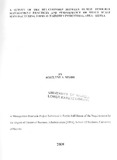| dc.description.abstract | The topic of the research project was a survey of the relationship between human resource management
practices and performance of small scale manufacturing firms in Nairobi’s industrial area -Kenya. The
main objective of the study was to establish the relationship between human resource management
practices and the performance of small scale manufacturing firms in Nairobi. The survey intended to
benefit the government, the small scale firms operating in Nairobi’s industrial area in Kenya and future
researchers. The research questions were systematically generated from the objectives. In the data
analysis, descriptive statistics and factor analysis were used to help draw comparisons and conclusions
based on the results. It was assumed in the data analysis that the results obtained were quite
representative for the general population considering that the sampled size.
The conclusions of the study are based on the research questions leading to the main purpose of the
study. First, the following best practices form the small scale manufacturing firms’ human resources
management best practices: The management conducts cost - benefit analysis to assess the effectiveness
of the training program; employees' promotion is based on the length of stay at the enterprise; the
enterprise has a heavy reliance on team structure for disseminating information (team briefing),
structuring work, (team working) and problem solving; job design is something management
consciously does in order to provide jobs that have a considerable level of intrinsic satisfaction.
Secondly, the human resources management best practices can be broken into three components:
recruitment practices and policies which include based recruitment more on aptitude and trainability
rather than formal paper qualifications; employee involvement in decision making which include
assessment and payment systems based merit pay and profit sharing where promotion is based on the
length of stay at the enterprise; and lastly employees training and performance which includes
employees' promotion is based on performance, systematic analysis to determine the needs for training
programs. Thirdly, the small scale manufacturing firms’ performance compared with that of their
competitors over the past three years resulting from human resources management best practices has
been characterized with the following: improved quality of products, enhanced development of new
products, increased ability to attract and retain essential employees, high-performing members of the
work force, increased overall performance, improved relations between management and other
employees; and that among employees in general. Lastly, HRM practices can help improve a firm’s
x
performance. Indeed business strategies and HRM policies interact according to organizational context
in determining business performance. | en |

